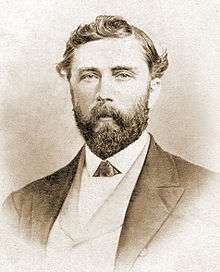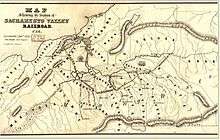Theodore Judah
| Theodore Dehone Judah | |
|---|---|
 T.D. Judah c1862 | |
| Born |
March 4, 1826 Bridgeport, Connecticut |
| Died |
November 2, 1863 (aged 37) Sacramento, CA, 8th & K streets |
| Cause of death | Yellow fever |
| Other names | "Crazy Judah" |
| Education | Rensselaer Polytechnic Institute |
| Occupation | Civil engineer |
| Employer | Central Pacific Railroad |
| Known for | railroad pioneer |
| Title | Chief Engineer, CPRR |
| Spouse(s) | Anne Pierce Judah |
| Signature | |
|
| |

Theodore Dehone Judah (March 4, 1826 – November 2, 1863) was an American railroad and civil engineer who was a central figure in the original promotion, establishment, and design of the First Transcontinental Railroad. He found investors for what became the Central Pacific Railroad (CPRR). As chief engineer, he performed much of the land survey work to determine the best route for the railroad over the Sierra Nevada mountains.
Early life and education
Theodore Judah was born in 1826 in Bridgeport, Connecticut, the son of an Episcopal clergyman. After his family moved to Troy, New York, Judah studied engineering at Rensselaer Polytechnic Institute.
At age 21 Judah married Anne Pierce on May 10, 1847. Theirs was the first wedding in the then new St James Episcopal Church of Greenfield, Massachusetts.
Career
After working on a number of railroads in the Northeast, Judah was hired as the Chief Engineer for the Sacramento Valley Railroad in California. It was the first railroad built west of the Mississippi River. Throughout the 1850s, Judah was known as "Crazy Judah" for his idea to build a railroad through and over the Sierra Nevada, a project which many people at the time considered impossible.
CPRR
As the chief engineer of the Central Pacific Railroad (CPRR), Judah surveyed the route over the Sierra Nevada along which the railroad was to be built during the 1860s. Failing to raise funds for the project in San Francisco, he succeeded in signing up four Sacramento merchants, known as the "Big Four": Leland Stanford, Collis P. Huntington, Mark Hopkins, and Charles Crocker. They managed financing and construction of the CPRR.
Death
Judah died of yellow fever on November 2, 1863. He contracted the disease in Panama on a voyage with his wife to New York City, apparently becoming infected during their land passage across the Isthmus of Panama. He was traveling to New York to seek alternative financing to buy out the Big Four investors. Anna took his body back to Greenfield, Massachusetts, where he was buried in the Pierce family plot in the Federal Street Cemetery.
Legacy and honors
- The CPRR named one of its steam locomotives (CP No. 4) after him. Judah crossed paths with the 19-ton locomotive bearing his name while on his way to New York.
- Mount Judah, an 8,245-foot peak in Placer County, CA, located adjacent to Donner Peak and Mount Lincoln in the Sierra Nevada Tahoe National Forest, was formally named for Judah on October 18, 1940 by the U.S. Board on Geographic Names.[1][2][3] Running through the mountain about 1,000 below the summit is the 10,322-foot long single track UPRR Sierra Grade Tunnel #41 (aka "The Big Hole") which was opened in 1925 and carries both UPRR freight and Amtrak passenger trains in both directions over Donner Summit between Soda Springs and Eder. This route bypasses the original, now abandoned 1868 CPRR "Summit Tunnel" (#6) surveyed by Judah which is located a mile to the north and had remained in service until 1993.[4]
- Judah Street in San Francisco and its N-Judah Muni streetcar line are named after him.
- Memorial plaques dedicated to him have been erected in Folsom and Sacramento, California
- Elementary schools in Sacramento and Folsom are named after Judah.[5][6]
Within days of Judah's death, the CPRR's first locomotive, Gov. Stanford, made a trial run over the new railroad's first 500 feet of track.
See also
References
- ↑ "Feature Detail Report for Mount Judah, Placer County, CA (ID #262032) bound on the west by Sugar Bowl basin, 1.1 km (0.68 mi) south of Donner Peak and 1.6 km (0.99 mi) northeast of Mount Lincoln. (US-T121)" U.S. Board on Geographic Names, Washington, D.C.
- ↑ U.S. Board on Geographic Names Decision Card, October 18, 1940
- ↑ "OnTheSummit: Donner/Judah Peaks OnTheSummit.net
- ↑ "Central Pacific Transcontinental Railroad, Tunnel No. 41, Milepost 193.3, Donner, Placer County, CA Library of Congress
- ↑ http://schools.scusd.edu/tjudah/
- ↑ "Archived copy". Archived from the original on 2016-11-30. Retrieved 2016-10-30.
Bibliography
- Ambrose, Stephen E. (2000). Nothing Like It In The World; The men who built the Transcontinental Railroad 1863-1869. Simon & Schuster. ISBN 0-684-84609-8.
- Bain, David H. Empire Express: Building the First Transcontinental Railroad (2000)
- Cooper, Bruce C. (2005). Riding the Transcontinental Rails: Overland Travel on the Pacific Railroad 1865-1881. Philadelphia: Polyglot Press. ISBN 1-4115-9993-4.
- Cooper, Bruce Clement (2010). The Classic Western American Railroad Routes. New York: Chartwell Books/Worth Press. ISBN 0-7858-2573-8.
- John Debo Galloway; The First Transcontinental Railroad: Central Pacific, Union Pacific (1950)
- Theodore Henry Hittell, History of California (1898) vol 4
- White, John H. Jr. (Spring 1986). "America's Most Noteworthy Railroaders". Railroad History. 154: 9–15. ISSN 0090-7847. JSTOR 43523785. OCLC 1785797.
| Wikimedia Commons has media related to Theodore Judah. |